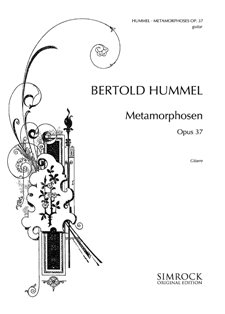Metamorphoses for guitar op. 37 (1969)

I. Recitative
II. Intermezzo
IV. Finale
First Performance:
December 4, 1974 / Regensburg / University
Jürgen Libbert
Duration: 8 Minutes
Publisher: N. Simrock Hamburg-London (Boosey & Hawkes) ISMN: 9790221108586
Video: Works by Hummel on youtube
The Würzburg composer Bertold Hummel wrote the four movements of his Metamorphoses in 1969 and dedicated the work to the guitarist Siegfried Behrend. Hummel uses twelve-tone technique not in the strict Schoenberg sense but rather freely, more like Alban Berg. As an example, Hummel allows a tone-row - each movement has its own, related to the others - to begin again before he has used all its tones. Typical for his treatment of twelve-tone series are the replacing of tones, fragmentation and repetitions, so that tonal fields develop. The title Metamorphoses describes a fundamental principle of all composing, indeed of all art-forms: that of transformation, of self-transformation. The first movement, Recitative, demonstrates, so to speak, a basic metamorphosis - that of a single tone, initially set in motion, as if loading up with energy, so as to be able then to traverse the entire range of tones. Starting with e - because of its tuning, e is the centre of gravity for guitar sounds - the Recitative conquers step by step the whole range of tones, until, after about a third of the movement, with the exposed high notes e-flat and d-flat, the twelve tones of the octave have sounded at least once and the basic profile of the tone-row is now defined. Piece by piece, the tone-row is tested for what it offers the player. The last three bars are a quintessence. Below the e' (the pitch of the first string), the complete row is heard. All the material available to the composer is thus presented. The instruction "burlesque" for the second movement, an Intermezzo, indicates for the player not only how he should play the piece, but also characterises the three-section form (A-B-A') itself. Burlesque applies to at least four aspects: the wide intervals in the tone-row, the cuckoo-calls (tones 6, 7, 8 and 4 of the inverted tone-row), the distorted tone-row before the final chord and the fact that the tone-row usually appears in inversion, that is, standing on its head. The third movement, Melancolia, is like a reminiscence of lute-song. Over chords formed with grouped tones from the row, a melody with scale-passage ornaments develops. The Finale, a closing hoedown, takes its character from an eight-tone row. The principal interval is the second. From this material, Hummel forms, using sometimes excessive repetitions, a kind of pendulum movement that works against the forward impulse. The piece paces on the spot, seems to get stuck, but then frees itself abruptly. In this way alone, with this quite special kind of progressive motion, the Finale reaches the closing chord. This time, the tension is resolved so suddenly, that the tone-row (as inversion) tumbles head-over-heels down to the fundamental tone, the a. An A-major chord joins on: undisturbed tonal splendour - this is Bertold Hummel's little surprise bringing everything to a satisfying conclusion.
Thomas Wirth (in CD-Booklet "Metamorphosen - Kurt Hiesl, Gitarre", AHO-Recording 1997)

Preface (Edition Simrock)
The
Metamorphoses for Guitar, op. 37 were composed by
Bertold Hummel in 1969 at the instigation of the
guitarist Siegfried Behrend. It was the first time in
all his varied composing experience that he looked
intensely at the sounds available on this instrument. In
four differently characterised movements he transforms -
corresponding to the title - the twelve-tone row chosen
for each movement very freely, so that, through changes
in the order, through fragmentation and repetition,
tonal fields continually develop. Beauty of sound and
comprehensible musical processes are in the foreground
of the compositional concept.
The present edition includes all the changes made by my
father since the first edition in 1975 following
suggestions by Anton Stingl (1978) and Siegfried Behrend
(1990) and as a result of his own experiences with two
later works for guitar in the years 1985 and 1990
(Concertante Music for Guitar and String Quartet or
String Orchestra, op. 89a/b and Phantasus - Song Cycle
on Poems of Arno Holz, op. 93)
Martin Hummel